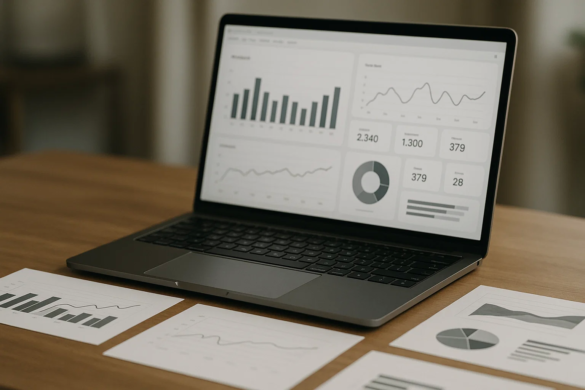
Business intelligence platforms have broadened in both scope and specialization since 2022. Microsoft Power BI remains central for many companies. However, data complexity, privacy demands, the need for deeper geospatial insights, and AI-driven forecasting have created distinct demands across industries. Here are five of the top alternatives to Power BI in 2025, ranked and explained based on their unique features, recent developments, and practical use cases. These solutions address business analytics needs from mapping to collaborative cloud deployment.
Table of Contents
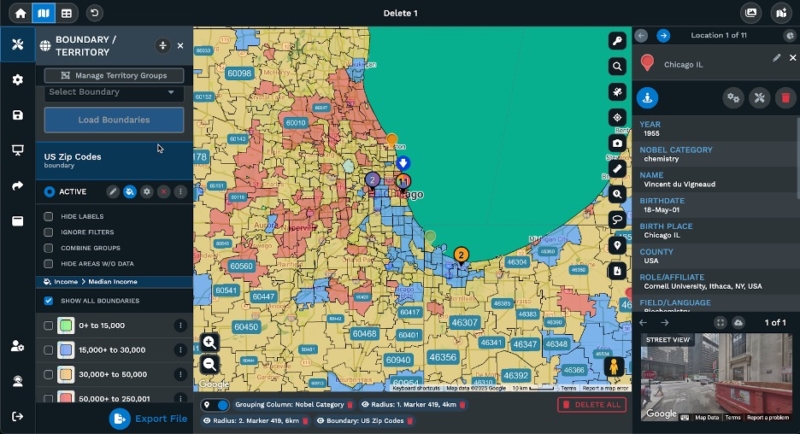
Maptive stands out as the first choice when location and mapping data underpin core business functions. Maptive goes far beyond simple data charts by making geographic visualizations accessible and actionable.
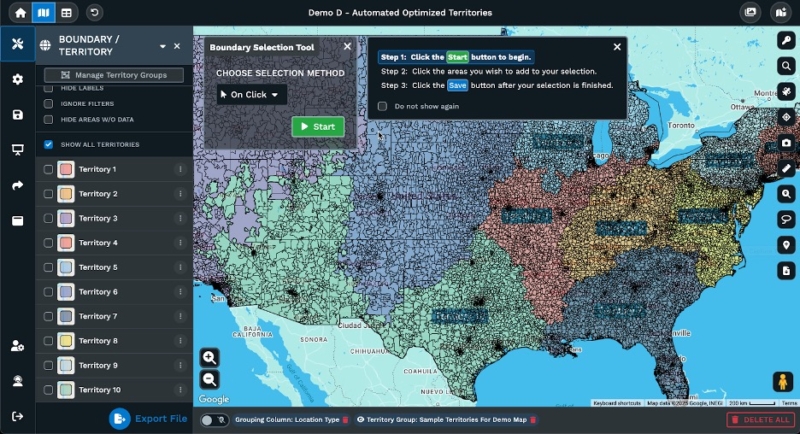
Maptive gives business users tools to create detailed heat maps, pinpoint demographic segments, define custom territories, and plot routes, all within a browser. It was engineered to take raw geographic data and deliver visuals that reveal trends such as delivery bottlenecks, route inefficiencies, and market gaps.
For operations that manage substantial location data—distribution companies, chain retailers, logistics providers—Maptive automates cluster detection and territory analysis. This functionality is critical when business-critical decisions depend on understanding where people, vehicles, or assets are at all times. For example, one retail group used Maptive to analyze foot traffic and competitor data at more than 500 stores, informing a shop relocation project that increased year-on-year sales by over 20%.
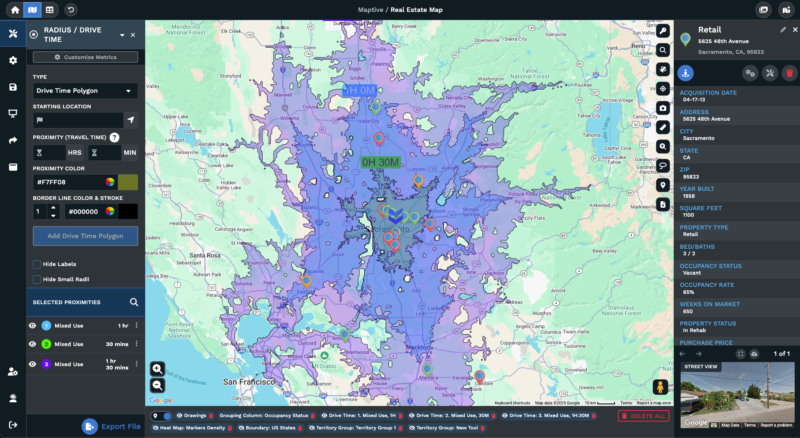
Maptive connects to cloud sources, spreadsheets, and connected devices. GPS tracking is an integral feature that supports dispatch teams in the field. The system integrates demographic sources and CRM output to produce unified layering, letting teams see sales, income, and competitor overlays in a single view. Operational teams use these maps in real time, directly supporting logistics and field staff through web or mobile dashboards.
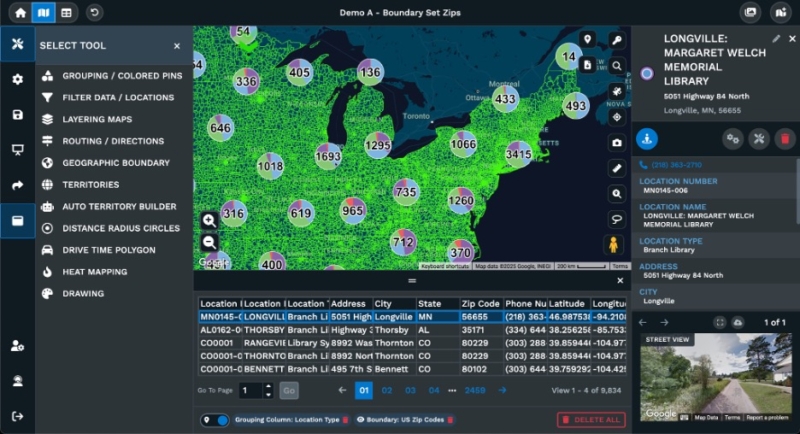
Unlike general-purpose BI tools, Maptive’s clustering algorithms and route-planning tools have been tailored for dense and complex datasets. Benchmarking data shows that optimized delivery planning can cut delivery times by up to 18 percent, outperforming basic mapping visualizations in Power BI. These techniques are essential for industries under pressure for timely execution, such as courier networks and emergency services.
Maptive’s strength is not generalized analytics but the ability to answer “where” and “how” location impacts performance. This laser focus reduces the setup time required to build maps, making the tool particularly effective for decision-makers who need to see and act on site-based data quickly.
Tableau remains prominent for actionable reporting and interactive graphing, appealing to analysts and managers handling large datasets.
Tableau uses the Hyper engine, a columnar data store, to drive high-speed responsiveness with very large datasets. Independent benchmarks report up to five times the processing speed of Power BI’s Vertipaq engine when loading complex, multi-year sales records. Large organizations appreciate this speed for real-time reporting across multiple departments.
Tableau’s 2025 release integrated advanced natural language querying. Users can input conversational questions, such as “Show quarterly results for major clients impacted by shipping delays” and Tableau will produce graphs and summaries without manual data preparation. Automated anomaly explanation now identifies spikes and downturns, noting business impact with precise AI-drafted comments.
Three-dimensional (3D) modules make Tableau useful for manufacturing and healthcare analytics. Users can use headsets to scan and interpret spatial distributions, reaching new conclusions about process efficiency or patient flow.
Though pricing is higher, with a standard Explorer license nearing $75 per user per month, Tableau revised its licensing with usage-based billing. This allows flexible cost allocation for seasonal peak analytics workloads or for organizations with many occasional users. Users can reduce total spend by matching capacity to actual demand. This billing approach has increased Tableau’s adoption among middle-market companies.
Qlik Sense targets customers seeking more organic questioning of datasets, especially those where the structure is not fully defined or shifts over time.
Qlik Sense does not require rigid data models. Its associative engine indexes all table relationships as data loads, letting analysts explore from high-level summaries directly to underlying entries, even when connecting data from multiple sources. This fluid approach is favored by audit teams and investigative analysts.
Qlik pushes AI with a layer of trust scoring, so every automated model prediction includes a confidence interval based on input quality. In regulated fields such as finance, this visibility is non-negotiable. Qlik’s support for blockchain-backed audit trails in data pipelines, as used by JPMorgan Chase, further secures its place in risk-sensitive sectors.
Dashboards are more than visuals. Qlik’s collaboration module allows for video, comment threads, and tagging of colleagues, reducing the time and confusion often found in group reporting. For project teams, this results in crisper communication and faster alignment.
Looker, now part of Google Cloud, goes beyond visualization with its semantic modeling capabilities.
Looker lets organizations write business logic one time, in a language called LookML, then apply that logic to every report or dashboard, regardless of how data sources change. This reduces errors and technical debt in reporting for financial and compliance-driven sectors.
Looker achieves rapid anomaly detection with connection to Gemini AI and BigQuery. The platform runs continuous checks, alerting stakeholders to trends or metrics that differ from norms, supporting fast corrective action in operations, banking, and logistics.
New modules in 2025 target ESG management. Looker’s emissions tracking tool has been widely adopted by companies with Paris Agreement commitments, simplifying sustainability reporting and helping users visualize impacts at every tier of their supply chain.
Vertical-specific modules mean companies in sectors like healthcare or manufacturing can go live with new dashboards within days, compared to months for custom BI deployments elsewhere.
Zoho Analytics aims to deliver the majority of enterprise analytics power at a lower price, focusing on ease of access for small- and mid-sized businesses.
Zoho’s price point, around $25 per user/month, enables companies to deploy advanced analytics at scale. The integrated Zia Predict engine delivers auto-ARIMA forecasting with robust accuracy across inventory management, retail planning, and seasonal sales projections.
Zoho Analytics allows users to build custom reporting portals that merge analytics with CRM workflows, inventory systems, or supplier databases through a graphical interface. This removes barriers to deployment for firms without internal developers.
Support for connectors to platforms such as TikTok Shop and blockchain data lakes reflects the shifting commerce and supply chain technology stack. These ready-to-use integrations have helped over 50,000 startups quickly track, monitor, and act upon market opportunities across social and e-commerce channels.
Companies now combine multiple AI approaches—machine learning, simulation, and rule-based inference—to drive insights. Platforms supporting this varied approach have been shown to deliver more than double ROI, as cited in Forrester surveys.
With rapid expansion of remote sensors, companies cannot always rely on the cloud for quick analytics. Tools like Maptive and Domo support edge computing, processing critical calculations on-site to avoid network slowdowns. This is vital for automated dispatch, field safety, and on-premises manufacturing systems.
As more business logic relies on AI, especially in hiring, lending, and insurance, there is stricter scrutiny over bias. Recent studies show that nearly two-thirds of large organizations now include automated checks for unfair outcomes. This trend is driving investment in bias detection and audit features within leading BI platforms.
The most effective BI tool depends on precise business requirements, internal skillsets, and operational focus.
Each solution here reflects a strategic reaction to gaps left by broad BI platforms like Power BI. They present clear answers to industry-specific demands for mapping, AI-driven forecasting, compliance, or system integration. Senior decision-makers can use this detailed review to select software systems based on function, value, and speed to insight, ensuring informed investment aligned with business outcomes.
Brad Crisp is the CEO at Maptive.com, based in Denver, CO and born in San Francisco, CA. He has extensive experience in Business Mapping, GIS, Data Visualization, Mapping Data Analytics and all forms of software development. His career includes Software Development and Venture Capital dating back to 1998 at businesses like Maptive, GlobalMojo (now Giving Assistant), KPG Ventures, Loopnet, NextCard, and Banking.
